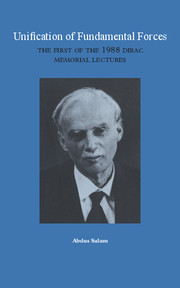Foreword
Published online by Cambridge University Press: 08 January 2010
Summary
From time to time, science succeeds in unifying apparently diverse sets of phenomena. These unifications provide some of the most impressive achievements in the sciences. Unification, in this sense, means understanding how apparently different effects are really aspects of a single underlying thing. In the nineteenth century, for example, electricity and magnetism were unified. They are different, but they are intimately interconnected, and in general situations it is impossible to imagine one without the other.
In physics, one of the unifications of the present century has been that of electromagnetism with the weak force. These are apparently totally different. Electromagnetism ranges across any distance, from atomic to astronomical. The weak force, on the other hand, operates deep within the atomic nucleus (for example) to produce radioactive decay. This unification was mainly the work of three men, Sheldon Glashow, Abdus Salam and Steven Weinberg. They made use of earlier theoretical ideas of two British physicists Peter Higgs and Tom Kibble. Finally, a Dutch theoretician, Gerard t' Hooft, put the equations into a form in which any competent physicist could handle them in standard ways. The experimental implications of all this are at present being tested with the new high-energy colliders at CERN, Fermilab and Stanford.
- Type
- Chapter
- Information
- Unification of Fundamental ForcesThe First 1988 Dirac Memorial Lecture, pp. vii - xPublisher: Cambridge University PressPrint publication year: 1990

